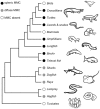Melanomacrophage Centers As a Histological Indicator of Immune Function in Fish and Other Poikilotherms
- PMID: 28769932
- PMCID: PMC5512340
- DOI: 10.3389/fimmu.2017.00827
Melanomacrophage Centers As a Histological Indicator of Immune Function in Fish and Other Poikilotherms
Abstract
Melanomacrophage centers (MMCs) are aggregates of highly pigmented phagocytes found primarily in the head kidney and spleen, and occasionally the liver of many vertebrates. Preliminary histological analyses suggested that MMCs are structurally similar to the mammalian germinal center (GC), leading to the hypothesis that the MMC plays a role in the humoral adaptive immune response. For this reason, MMCs are frequently described in the literature as "primitive GCs" or the "evolutionary precursors" to the mammalian GC. However, we argue that this designation may be premature, having been pieced together from mainly descriptive studies in numerous distinct species. This review provides a comprehensive overview of the MMC literature, including a phylogenetic analysis of MMC distribution across vertebrate species. Here, we discuss the current understanding of the MMCs function in immunity and lingering questions. We suggest additional experiments needed to confirm that MMCs serve a GC-like role in fish immunity. Finally, we address the utility of the MMC as a broadly applicable histological indicator of the fish (as well as amphibian and reptilian) immune response in both laboratory and wild populations of both model and non-model vertebrates. We highlight the factors (sex, pollution exposure, stress, stocking density, etc.) that should be considered when using MMCs to study immunity in non-model vertebrates in wild populations.
Keywords: comparative immunology; fish immunology; germinal center; melanomacrophage center; non-model organisms.
Figures


Similar articles
-
Hepatic melanomacrophage centers in the arctic cultured fish Cyclopterus lumpus are not indicative of its health state.Aquaculture. 2024 Feb 25;581:740417. doi: 10.1016/j.aquaculture.2023.740417. Aquaculture. 2024. PMID: 39175872 Free PMC article.
-
Effect of ranching time on melanomacrophage centres in anterior kidney and spleen of Southern bluefin tuna, Thunnus maccoyii.Fish Shellfish Immunol. 2016 Dec;59:358-364. doi: 10.1016/j.fsi.2016.11.014. Epub 2016 Nov 5. Fish Shellfish Immunol. 2016. PMID: 27826111
-
Melanomacrophages and melanomacrophage centres in Osteichthyes.Cent Eur J Immunol. 2019;44(2):201-205. doi: 10.5114/ceji.2019.87072. Epub 2019 Jul 30. Cent Eur J Immunol. 2019. PMID: 31530990 Free PMC article. Review.
-
Characterisation and 3D structure of melanomacrophage centers in shorthorn sculpins (Myoxocephalus scorpius).Tissue Cell. 2019 Apr;57:34-41. doi: 10.1016/j.tice.2019.02.003. Epub 2019 Feb 6. Tissue Cell. 2019. PMID: 30947961
-
Dietary Approaches to Attain Fish Health with Special Reference to their Immune System.Curr Pharm Des. 2018;24(41):4921-4931. doi: 10.2174/1381612825666190104121544. Curr Pharm Des. 2018. PMID: 30608037 Review.
Cited by
-
Differential Effects of Dietary Supplementation of Krill Meal, Soybean Meal, Butyrate, and Bactocell® on the Gene Expression of Atlantic Salmon Head Kidney.Int J Mol Sci. 2020 Jan 30;21(3):886. doi: 10.3390/ijms21030886. Int J Mol Sci. 2020. PMID: 32019111 Free PMC article.
-
Identification of a pharyngeal mucosal lymphoid organ in zebrafish and other teleosts: Tonsils in fish?Sci Adv. 2023 Nov 3;9(44):eadj0101. doi: 10.1126/sciadv.adj0101. Epub 2023 Nov 1. Sci Adv. 2023. PMID: 37910624 Free PMC article.
-
Food Safety: Pathological and Biochemical Responses of Nile Tilapia (Oreochromis niloticus) to Parasitological Infestation and Heavy Metals Pollution in Aquaculture System, Jeddah, Saudi Arabia.Animals (Basel). 2024 Dec 27;15(1):39. doi: 10.3390/ani15010039. Animals (Basel). 2024. PMID: 39794982 Free PMC article.
-
Hepatic melanomacrophage centers in the arctic cultured fish Cyclopterus lumpus are not indicative of its health state.Aquaculture. 2024 Feb 25;581:740417. doi: 10.1016/j.aquaculture.2023.740417. Aquaculture. 2024. PMID: 39175872 Free PMC article.
-
Immunoglobulin VDJ repertoires reveal hallmarks of germinal centers in unique cell clusters isolated from zebrafish (Danio rerio) lymphoid tissues.Front Immunol. 2022 Dec 8;13:1058877. doi: 10.3389/fimmu.2022.1058877. eCollection 2022. Front Immunol. 2022. PMID: 36569890 Free PMC article.
References
-
- Press CM, Dannevig BH, Landsverk T. Immune and enzyme histochemical phenotypes of lymphoid and nonlymphoid cells within the spleen and head kidney of Atlantic salmon (Salmo salar L.). Fish Shellfish Immunol (1994) 4:79–93.10.1006/fsim.1994.1007 - DOI
-
- Bermúdez R, Vigliano F, Marcaccini A, Sitjà-Bobadilla A, Quiroga MI, Nieto JM. Response of Ig-positive cells to Enteromyxum scophthalmi (Myxozoa) experimental infection in turbot, Scophthalmus maximus (L.): a histopathological and immunohistochemical study. Fish Shellfish Immunol (2006) 21:501–12.10.1016/j.fsi.2006.02.006 - DOI - PubMed
-
- Wolke RE. Piscine macrophage aggregates: a review. Annu Rev Fish Dis (1992) 2:91–108.10.1016/0959-8030(92)90058-6 - DOI
Publication types
Grants and funding
LinkOut - more resources
Full Text Sources
Other Literature Sources
Research Materials
Miscellaneous

